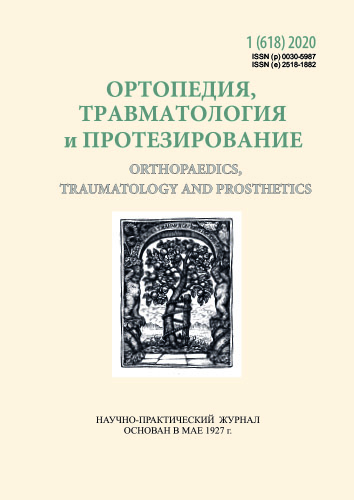Frequency of complications at shaft fractures according to kharkiv traumatological medical-social expert committee (MSЕC) data
DOI:
https://doi.org/10.15674/0030-59872020120-25Keywords:
shaft fractures, frequency of nonunions, osteomyelitis, neuropathyAbstract
Objective: to determine the incidence of complications after treatment of shaft fractures according to the inter-regional Specialized Traumatological Medical and Social Expert Commission in Kharkiv and Kharkiv region.
Methods: we studied the incidence of nonunions, osteomyelitis, radial nerve neuropathy in 773 patients with shaft fracture of the extremities, who underwent primary examination at the MSEC for the period 01.01.2016–31.12.2018. Among them, 96 % were patients of preretirement age. There were 461 patients with tibia fractures, forearm — 49, femur — 173, humerus — 90. The frequency of nonunion in subgroups is analyzed depending on the method of fragments fixation.
Results: after bone fragments osteosynthesis at isolated tibia fractures nonunion was found in 11.9 % of cases, at intramedullary blocking nail — 16.0 %, external rod fixators — 3.0 %, Ilizarov fixator — 18.4 %, plaster cast bracing — 7.6 %. After treatment of femur fracture with plate osteosynthesis, nonunion was found in 9.4 %, after intramedullary nailing — in 12.8 %. At humerus fractures and forearm fractures which were treated with plate osteosynthesis, nonunion was recorded in 19.0 and 28.6 % of patients respectively, and radial nerve neuropathy – was observed in 25.0 and 26.4 %. The incidence of osteomyelitis at internal osteosynthesis was 2.9– 7.7 %.
Conclusions: osteosynthesis was used in 36.6 % of cases of tibia shaft fractures and was the most common used method of fragments fixation in isolated shaft fractures: 64.9 % — femur; 75.6 % — humerus; 100.0 % — forearm bone fragments. The second most frequent method of fixation was intramedullary nailing osteosynthesis. The main complication of treatment was fragments nonunion, and in the case of plate osteosynthesis at humerus and forearm fractures was radial nerve neuropathy.
References
- Hak, D. J., Fitzpatrick, D., Bishop, J. A., Marsh, J. L., Tilp, S., Schnettler, R., Simpson, H., & Alt, V. (2014). Delayed union and nonunions: Epidemiology, clinical issues, and financial aspects. Injury, 45, S3-S7. https://doi.org/10.1016/j.injury.2014.04.002
- Ekegren, C., Edwards, E., De Steiger, R., & Gabbe, B. (2018). Incidence, costs and predictors of non-union, delayed union and Mal-union following long bone fracture. International Journal of Environmental Research and Public Health, 15(12), 2845. https://doi.org/10.3390/ijerph15122845
- Rupp, M., Biehl, C., Budak, M., Thormann, U., Heiss, C., & Alt, V. (2017). Diaphyseal long bone nonunions — types, aetiology, economics, and treatment recommendations. International Orthopaedics, 42(2), 247-258. https://doi.org/10.1007/s00264-017-3734-5
- Antonova, E., Le, T. K., Burge, R., & Mershon, J. (2013). Tibia shaft fractures: Costly burden of nonunions. BMC Musculoskeletal Disorders, 14(1). https://doi.org/10.1186/1471-2474-14-42
- Popsuishapka, O. K., Uzhegova, O. E., Litvishko, V. A. (2013). Frequency of nonunion of fragments in isolated diaphyseal fractures of long bones of the extremities. Orthopaedics, traumatology and prosthetics, 1(590), 39-43. — DOI: 10.15674/0030- 59872013139. [in Russian]
- Litvishko, V. O. (2019). Regularities of bone regeneration formation after diaphyseal fracture under conditions of functional treatment using an elastic-stable connection of fragments: dissertation of Doctor of Medical Sciences. Kharkiv. [in Ukrainian]
Downloads
How to Cite
Issue
Section
License
Copyright (c) 2020 Olexii Popsuishapka, Valerii Litvishko, Olga Uzhegova, Olga Pidgaiska

This work is licensed under a Creative Commons Attribution 4.0 International License.
The authors retain the right of authorship of their manuscript and pass the journal the right of the first publication of this article, which automatically become available from the date of publication under the terms of Creative Commons Attribution License, which allows others to freely distribute the published manuscript with mandatory linking to authors of the original research and the first publication of this one in this journal.
Authors have the right to enter into a separate supplemental agreement on the additional non-exclusive distribution of manuscript in the form in which it was published by the journal (i.e. to put work in electronic storage of an institution or publish as a part of the book) while maintaining the reference to the first publication of the manuscript in this journal.
The editorial policy of the journal allows authors and encourages manuscript accommodation online (i.e. in storage of an institution or on the personal websites) as before submission of the manuscript to the editorial office, and during its editorial processing because it contributes to productive scientific discussion and positively affects the efficiency and dynamics of the published manuscript citation (see The Effect of Open Access).














